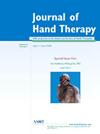儿童急性骨性槌状指和腱性槌状指保守治疗的疗效差异。
IF 1.8
4区 医学
Q2 ORTHOPEDICS
引用次数: 0
摘要
导言:腱性槌状指和骨性槌状指是两种截然不同的损伤,均表现为远端指间关节伸肌滞后。本研究旨在评估使用夹板保守治疗儿童急性骨性和腱性槌状指的结果差异:我们收集了在职业治疗门诊接受保守治疗的急性腱性或骨性槌状指患者受伤时的回顾性数据。患者在门诊接受检查。记录了疼痛、伸展滞后和屈曲损失。结果根据克劳福德标准进行分类:我们收集了 31 名患者(16 名骨性槌状关节炎患者和 15 名腱性槌状关节炎患者)的数据。我们发现骨性畸形患者年龄较大(平均 13.8 岁对 11.9 岁),我们还发现腱性畸形主要影响无名指,而骨性畸形主要影响中指。骨性和腱性槌伤都以男性多见。最初的伸指滞后度相同(中位数-18.5° vs -20°)。至于结果,我们发现两组患者在伸展滞后(中位数0° vs 0°,P = 0.538)和克劳福德标准评估(P = 0.570)方面都有很好的结果:讨论:槌状损伤,无论是腱性损伤还是骨性损伤,在儿童中都不常见。这两种损伤经常被放在一起研究,通常采用相同的方法进行外展夹板固定治疗。然而,成人中的证据清楚地表明,有不同的损伤,却以相同的方式出现。这项研究加强了儿童人口学方面的研究结果,但在治疗效果方面却没有发现。本文章由计算机程序翻译,如有差异,请以英文原文为准。
The outcome difference between acute bony and tendinous mallet fingers treated conservatively in children
Introduction
Tendinous and bony mallet are very different injuries presenting with extensor lag at the distal interphalangeal joint. This study is aimed to evaluate the outcome difference between acute bony and tendinous mallet fingers treated conservatively with a splint in children.
Materials and Methods
We collected retrospective data about patients at the time of injury with acute tendinous or bony mallet that were treated conservatively in our occupational therapy clinic. Patients were examined in the outpatient clinic. Pain, extension lag, and flexion loss were documented. Outcomes were classified according to the Crawford’s criteria.
Results
We collected data on 31 patients (16 bony and 15 tendinous mallet). We found the bony mallet patients to be older (mean 13.8 vs 11.9 years), We also found that tendinous mallet injuries affected predominantly the ring finger while bony mallet injuries affected predominantly the middle finger. Both bony and tendinous mallets tend to be more frequent in male. The extensor lag on initial was the same (median −18.5° vs −20°). As for the outcome, we found both groups to have excellent outcome in regard of the extension lag (median 0° vs 0° p = 0.538) and Crawford Criteria Assessment (p = 0.570).
Discussion
Mallet injuries, either tendinous or bony, are not common in children. They are often studied together and typically treated in the same way with extension splintage. Yet, the evidence in adults clearly shows there are different injuries, which present in the same way. This study reinforces these findings in children regarding demographic findings but not for the treatment outcome.
求助全文
通过发布文献求助,成功后即可免费获取论文全文。
去求助
来源期刊

Journal of Hand Therapy
医学-外科
CiteScore
3.50
自引率
10.00%
发文量
65
审稿时长
19.2 weeks
期刊介绍:
The Journal of Hand Therapy is designed for hand therapists, occupational and physical therapists, and other hand specialists involved in the rehabilitation of disabling hand problems. The Journal functions as a source of education and information by publishing scientific and clinical articles. Regular features include original reports, clinical reviews, case studies, editorials, and book reviews.
 求助内容:
求助内容: 应助结果提醒方式:
应助结果提醒方式:


